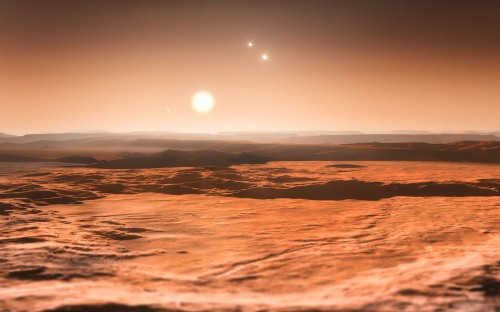
Artist’s impression of suns rising over Gliese 667C. (Courtesy: ESO/M Kornmesser)
By Hamish Johnston
No, it’s not Tatooine. This is an artist’s impression of the view from the exoplanet Gliese 667Cd looking towards the planet’s parent star (Gliese 667C). In the background to the right, the more distant stars in this triple system (Gliese 667A and Gliese 667B) are visible and to the left in the sky is one of the other planets, the newly discovered Gliese 667Ce, can be seen as a crescent.
The star known as Gliese 667C appears to be hosting at least six planets, three of which are “super-Earths” that are found in the star’s habitable zone. This zone is the set of orbits where liquid water could exist, making the trio good candidates for the search for life.
“This is the first time that three such planets have been spotted orbiting in this zone in the same system,” explains Paul Butler of the Carnegie Institution for Science in Washington, DC. Butler was part of the team that studied the system using data collected by ESO’s 3.6-m Very Large Telescope and the W M Keck Observatory.
The super-Earths are more massive than Earth, but smaller than giant planets such as Uranus or Neptune. Gliese 667C, on the other hand, is just over one-third of the mass of the Sun. According to the team, the discovery provides further evidence that such low-mass stars are currently the best targets for searching for potentially habitable planets. That’s good news for those searching for signs of extraterrestrial life because about 80% of the stars in the Milky Way are of this type.
You can read more about the discovery here.
Many such Earthy trinity and more complex configurations are on the way in the near future showing richness of the cosmos.